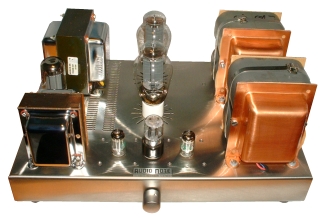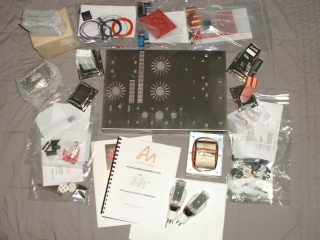|
||||||||||||||||||
|
The following review is split into two separate parts. The first is dedicated to the kit as a kit; whereas the second part is dedicated to the resulting piece of hi-fi equipment and its performance as an audio reference.

| PART 1 - The Build |
| Introduction |
When I ordered my DAC kit, I did so from AudioNote UK. Since then, however, kit operations has moved to Canada so I did not know at first what kind of operation I would be buying from. However, after a few e-mails and phone calls, I found that the new head of operations (Brian Smith) was trustworthy, enthusiastic, and dedicated to his job. In fact, the new operation seem to be highly pro-active in pushing the kits further and further toward the high end of hi-fi's finished products.
It was explained to me from the offset that I was one of the first people to be in receipt of this particular kit, and told what the tweaks and alterations were intended to be. The option of waiting for such things as the intended new chassis design and various hard-wiring variations were plainly, and enthusiastically, laid in front of me from the start - rather than the all too familiar 'grab the money and run' approach. So that made a nice change. I decided, however, to go with the then current offering - I could always upgrade things in the future (one of the advantages of building it yourself is that you end up knowing the thing inside-out, making upgrades a much easier and informed process).
It must be noted at this point that the Kit1, in any of its forms, is perhaps not a kit for the complete novice. If you fit this description then I would recommend something like the Kit4 or DAC Kit 1.1 (from the same supplier) to get you started as these involve much less wiring.
| About the Kit1 Range |
- Kit1 Basic
- Kit1 Signature
- PQ Kit1
- PQ Signature Kit1
For more information and pricing, please visit the AudioNoteKits.com website.
| Ordering and Dispatch |
The box itself was heavy - weighing in at 63lbs - mostly due to the huge TRANS300 output transformers that are one of the most unique and compelling features of this amplifier. The kit was extremely well packed. The components themselves were of a very high standard, as promised from this kit. It was a pleasant surprise to find that those components not mentioned in the sales specification (such as speaker terminals, feet, etc) hadn't been skimped upon, as is quite often the case.

All electro-mechanical components are split into logical assembly bags - as are all the necessary nuts and bolts. All the component bags also contain a parts checklist. Your first job should be to check through these lists against the supplied contents, as encouraged by the manual - all were present and correct.
| Instructions |
I had decided from the start that I was going to document the build of the kit by writing a website at the same time, so the build took me much longer than it would have done normally. Having said that, however, it turned out to be a rather nice experience; having so many productive options open to me. What you it be tonight? Text for the website? Image processing? PCB assembly? Wiring? Graphics?...
Now that I have finished the build I feel a little lost not having all those options.
| Wiring |
| Fixing the Hardware |
| Difficulties to be aware of |
For me, the most difficult jobs were more to do with inadequate soldering equipment than anything else. 95% of the soldering was as I expected it to be but there were two soldering jobs that took me a little by surprise:
1. Soldering onto the speaker terminals.
2. Soldering the input wire.
I found that I didn't quite have enough wire to finish the job. This was down to the output transformers. The common primary leads weren't long enough to reach the PSU board and needed to be extended about 6 inches or so. Also, the output transformer's secondary leads on the one furthest from the back of the unit had to be extended just a couple of inches to reach the speaker terminals. As I wished to use the same high quality wire throughout, I contacted Brian at AudioNote Kits who sent me some more without hesitation, along with his apologies.
Now, I think that the above gripes are pretty trifling so long as you know about them in advance and can plan around them or seek further advice.
| Support |
| Conclusion (build) |
Although I would not recommend this particular kit to the complete novice, I think someone with a little experience could make it through the build with a little support.
More detailed information about my build experience can be found on my website at www.MostlyAudio.com.
Of course, it is all well and good building something - but how does it perform once finished? This brings us to Part 2 of this review - Performance...
| PART 2 - Performance |
I am happy to report that there is no detectable hum whatsoever; even with the volume turned to maximum. Nor is there any unwanted noise of any kind.
Before we go any further, it should be noted that new valve amps will tend not to perform at their best until they have had a few hundred hours of burn-in time. This is something I'm expecting; mainly because of the Black Gate capacitors which I have had experience of on previous occasions. These can take many hundreds of hours before they perform at their best.
The first thing I did was to listen to some CD's that I was very familiar with (avoiding modern over-produced or re-mastered albums), using the supplied Electro Harmonic 300B valves. Although there were definite improvements to the sound in some areas (mainly in the reproduction of cymbals), overall it was pretty much on par with my old Audion Silver Night 300B integrated. That was until I swapped over the 300B tubes!
So, using the same 300B's that I was used to listening to in the Audion (namely Golden Dragon 300B Super/4300A - this is an old version of the Golden Dragons; not the new differently shaped ones), the differences became immense. In retrospect, the Electro Harmonic 300B's made the amp sound like a very good transistor amp - detailed but dull. The Golden Dragons put some of the 'feeling' back into performances.
Classical music is more listenable than ever. This is mainly due to the fact that very low volume listening now has such a high resolution (i.e. you can hear much detail in even the most low level sounds). This also manifests itself in greater instrument separation - individual instruments can be be picked out by the ear even in the most complex of passages. Also, due to this increased resolution, acoustic instruments have a much richer and interesting sound. This is not just restricted to classical instruments, of course. Acoustic guitars, drums and cymbals also benefit greatly. Listening at low levels is very important to me because I tend to do a lot of my work at nights with the kids tucked up in bed and enjoy listening whilst working.
High volume levels too are a surprise. There is less 'blurring' of the sound. There is also a mystery here because I have, many times in the past, had problems going above a certain volume level. At first I put this down to my listening room, but it continued at exactly the same level when I moved house; into a bigger room. That left the amp and speakers as the main culprit. I have since had two new amps before this one and still the same so I was convinced that it was my speakers. Now, however, I can go up much further which again points to the old amps! Strange but true.
One of the most talked about improvements about SET amps is vocals. The PQ takes a giant leap here; vocals now have air and space around them. It does wonderful justice to Joni Mitchell, for example.
Stringed bass instruments such as double bass, bass cello, etc. suddenly have a silky smooth bass that is very well defined, controlled, and deep (probably due to those massive output transformers).
Another nice experience was suddenly being able to hear musicians breathing between musical phrases for the first time on many familiar recordings.
I think you can tell that I am very impressed by my new amplifier. You could say that I'm biased because I built it myself - I'm trying not to be but I know I'm proud of the fact. The amplifier is in its infancy right now and has only had about 40 hours burn-in up to now. I'm expecting more improvements once everything has settled - if it's anything like my experience with the AudioNote CDT-One, it'll go through all kinds of ups and downs before it really shines. Therefore, I'll be adding to this review at a later time. I also have in my possession some brand new genuine AudioNote 300B's that I haven't listened to yet. I'm holding myself back until the amp has burned in fully. So watch this space!
| Continued some weeks later... |
Firstly, I have a confession - I couldn't wait for full burn-in before installing the new 300B's. I'm glad I didn't because the difference, even then, was quite significant. These tubes seem to give a wonderful balance. While they are not as 'bright' at the top-end as the Golden Dragons, they do have the GD's resolution but to an equal degree throughout the audio range.
Well I think I can safely say the amp has achieved it's burn-in now. I am quite simply knocked out by the sound now that those special components have bedded themselves in. Again, it was an interesting experience listening to the changes over time and the way the frequency response shifted around before finally becoming totally transparent (very similar to my experiences with the burn-in of my CDT-One).
Despite the fact that the sound changed significantly throughout the review period, not once did I feel that the amp was in any way worse than my previous configuration. On the contrary, It has been a steady climb to a better system. Just remember, however, when you are dealing with any equipment that contains Black Gate capacitors, you do have to be very patient and allow a long, long period before drawing your final conclusions.
So, there we have it - a very happy kit builder with an amp that should see me through quite a number of upgrades in other areas of my system. I could, of course, upgrade the amp further by hardwiring and beefing up the power supply further but I think it is fine and detailed enough as it is for the time-being and appears to be the leading component in my system. Time for other things to catch up now, I think.
Written by Paul Brookes
Published 13th June 2005
| Links |
| AudioNote PQ Signature Kit1 Build Process |
|
|
